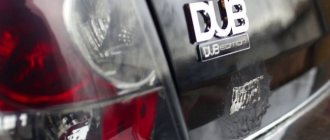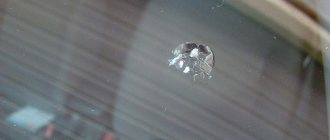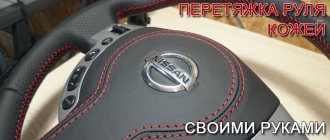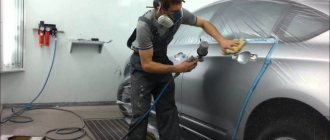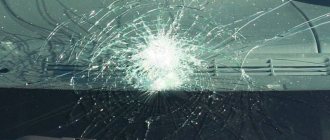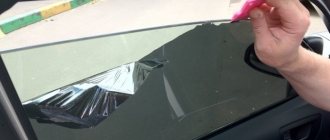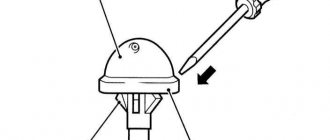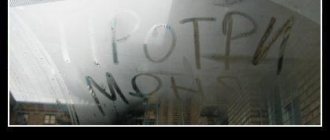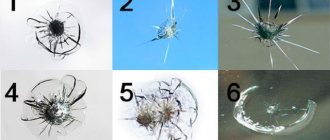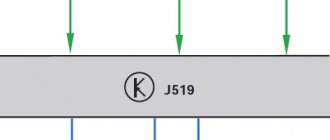Today we’ll look at how to polish a windshield with your own hands.
There are only two ways to smooth out scratches. The simplest is to fill them with a special acrylic composition, which is applied like a liquid, dries and becomes transparent, leveling out defects. Another way to get rid of scratches is abrasive polishing. For this, special pastes are used. Abrasive pastes for polishing paintwork are not suitable, since windshield is much harder than varnish or paint. Cerium oxide is widely used as an abrasive. It is included in some modern abrasive pastes for glass. It can be used by mixing with clean water. Content:
- About polishing
- Sanding before polishing
- Recommendations
- What polishing wheels should I use?
- Polishing instructions
Polishing a windshield with your own hands is a rather labor-intensive process. First of all, it is important to mix the cerium oxide with water in the correct proportions to create the correct paste consistency. It is also important to choose the right polishing wheel.
Do not overheat the windshield by polishing in one place for too long. This will give an optical effect of its distortion (curvature), which will be visually noticeable during further operation of the car.
Ultimately, with precautions in mind, the process is not too different from polishing paintwork. Only other compounds and polishing wheels are used. You need to polish the entire surface slowly, without stopping in place. You need to be patient, since glass polishes slower than paint, and there is no way to speed it up.
Sanding before polishing
Before polishing, you need to determine the depth of the scratches. If they are deep enough for your nail to catch on them, you will need to smooth them out first with sandpaper. The amount of abrasive depends on the depth of the scratch. It is necessary to use sandpaper based on silicone carbide. Try P2000 sanding paper first. If the defect is ground too slowly, increase the size to P1500 or P1200. You can grind with a larger abrasive, but then you need to remove traces of the larger abrasive with a smaller one. It is important to understand that sanding the windshield in certain areas can create a distorted effect. It must be sanded with water. Can be sanded with an electric sander. Next, proceed to polishing with cerium oxide.
Characteristics and properties of polishing powders
Polishing powder should be selected based on the following characteristics, which are usually indicated on the packaging:
- Dispersion of the material or particle size. The larger this indicator, the higher the abrasiveness. Highly abrasive powders must be used with caution as they can cause further serious damage. The danger of using coarse pastes is that as a result of microdamages, the angle of light reflection changes and glare may appear. They briefly blind the driver while driving. On average, the figure ranges from 0.8 to 1.2 microns.
- The polishing ability of a powder is measured in mg/min and depends not only on the particle size, but also on the composition of the powder.
- Chemical composition, in particular the presence and concentration of elements with polishing ability. Many car owners seek to purchase iron oxide in powder form for polishing. Another chemical element, the presence of which in the powder determines the polishing ability, is cerium oxide. Thanks to this element, the glass surface is polished evenly, and traces of unevenness are removed from it gently and without additional damage.
Recommendations
- It is better to protect the car body from splashes of paste. Polishing with cerium oxide is a lot of dirt. When mixed with water, the mixture turns out to be quite liquid, which scatters when polishing.
- It is necessary to apply pressure on the wheel (but not too much), polishing slowly.
- Before polishing, you can mark scratches on the back of the glass with a marker. These zones will be a guide to where the defects are located.
- The paste needs to be wet. If necessary, add the mixture.
- Cerium oxide must be mixed with water to obtain a composition that resembles the consistency of thin sour cream.
- Use a spray bottle to dampen the surface while polishing.
- It is better to polish in segments, because when working with the entire area, the paste dries quickly.
- Do not exceed 1500 rpm.
You may notice that the circle begins to slip and the speed slows down. This is possible when the surface is overheated, or there is insufficient amount of polishing mixture under the wheel. You need to stop and check the heating with your hand. If it is hot, you need to spray water. Next, wait a while, add more paste, then continue. If you ignore this braking, you can actually overheat the windshield and get optical distortion in certain areas.
Hand polishing paste
A universal remedy is GOI paste. It is used for polishing metals (including precious ones), plastics, phone screens and car windows. The paste is sold in the form of green bars. The basis of GOI is chromium oxide. Pasta is divided into 4 types:
- No. 4 is the roughest. Used to remove severe abrasions and shallow scratches.
- No. 3 removes dullness and promotes a slight shine.
- No. 2 and No. 1 give maximum (jewelry) shine.
For manual polishing, you need to rub a soft cloth with GOI paste and use it to polish glass or other materials. For maximum results, you can drop a mixture of gasoline and oil onto a cloth (preferably felt).
What polishing wheels should I use?
It all depends on the purpose of polishing, what imperfections you want to remove. You can use foam rubber (the denser the better) and a sheepskin circle. But especially for thorough deep polishing of the glass surface, a felt (felt) or leather circle is used. It presses the mixture more tightly to the surface and polishes better.
Sanding or polishing?
A clear distinction should be made between grinding and polishing. Professionals cannot confuse these two concepts. And among ordinary motorists, especially those with little experience, there are those who do not distinguish between these operations. However, there are significant differences.
As already mentioned, grinding acts on the glass with a coarse abrasive and removes a certain layer of it. Sanding is used to clean out deep scratches that cannot be removed in any other way. After this operation, the glass looks matte and it is impossible to see anything through it.
Under a microscope, the polished surface of the glass looks like the Himalayan mountains. In order for the glass to acquire optical transparency, it is necessary to turn the “mountains” into a plain. To do this, you need to apply a finer abrasive to the sanded surface. To speed up the leveling process, step-by-step polishing is used, when pastes are used alternately, the size of the abrasive filler decreasing each time.
On a note
In fact, grinding and polishing differ only in the depth of impact. But, nevertheless, these are different operations, since they have different goals. If grinding is needed to eliminate deep flaws, then polishing eliminates the effects of grinding or simply removes minor scratches.
Polishing is also called applying a protective polish. In this case, we are not talking about leveling the glass surface. Protective glass polish contains substances that have a dirt-repellent effect. Wiper blades remove water and dirt from treated glass much better.
It is also useful to read: How to choose the right products for polishing a car windshield
How to determine the required type of glass processing? Only minor scratches can be polished. Experts determine the extent of damage by eye. Amateurs can be advised to test scratches in the following way: try scratching the scratch with your fingernail, and if it starts to catch, then polishing is needed; if not, then such a scratch can be polished out.
Step-by-step process for abrasive glass polishing by machine
Windshield replacement
As mentioned above, it is recommended to use a grinding machine for abrasive processing - manual work will give less results and require more effort. Therefore, we choose a machine and polishing wheels with different degrees of grain size - from coarse grains to felt and foam rubber, which are used at the finishing stage.
The most popular companies producing different types of polishes are Sonax, TurtleWax, 3M, DoctorWax
The work process looks like this:
We thoroughly wash the windows we are going to work with and wipe them dry. We carry out degreasing using special means. We inspect the surface in good lighting and find the largest scratches and chips, marking them with a marker. Apply a coarse abrasive paste to these areas and begin sanding. At the same time, we make sure that the surface does not overheat - otherwise it may not withstand the high temperature and burst.
The pressure on the tool should be such as to maintain a reasonable balance between performance and caution. If you press hard, you can get a crack, and if you press weakly, the work will move too slowly and to no avail. After the areas with the most noticeable defects have been processed, change the circle towards decreasing the grain size and apply the following type of abrasive paste with a finer grain
We sand the entire surface, leveling the surface and getting rid of dullness. At this stage, it is necessary to eliminate differences so that the difference in relief is no more than one particle of abrasive. Make sure that the circle does not remain in one area for a long time - this creates the danger of grinding out the holes. After the unevenness has been eliminated, proceed to finishing - for this we take a felt wheel and final polishing paste. Apply the paste and carefully polish it over the surface with a machine. The final stage of work will be the application of a protective agent that will protect the surface from the appearance of new defects and preserve the results of your work for a long time.
For glass with moderate damage, when there are scratches, grinding with abrasives will be required
If serious scratches or chips are identified, use optical polish, which will fill the defect with its microparticles and make it invisible.
For the job, it is better to choose a sander that maintains a constant number of revolutions no matter how much force you apply to it. This will ensure uniform processing and effectiveness. Polishing and grinding are labor-intensive and time-consuming operations. Therefore, the amount of time and effort spent on work, as well as the quality of the surface, largely depends on the quality of the tool.
Cerium Oxide Abilities
The discovery of cerium's ability to prevent exposure to ultraviolet rays marked the beginning of its use in the production of medical glassware and instruments for laboratory and cosmetic purposes.
The introduction of cerium into the composition in the manufacture of portholes makes it possible to produce thick glasses that do not lose their protective properties and do not change their appearance when exposed to radiation.
In glass production it has two main directions:
- Polishing (ceramic, optical, technical, natural and artificial stones and crystals).
- Production (melting) of glass. By adding an element to the main composition of the mass and participating in the technological procedure, it is possible to produce glass that is perfectly transparent and flowing.
The role of the chemical element in the glass industry
The use of cerium oxide in the manufacture of glass mosaics or stained glass windows allows you to create ideal models that amaze with their ability to reflect sunlight.
The powder has gained particular popularity in the processing of ceramic products and cutting stones of various origins. Ceramic production is distinguished by the use of this material as the main stabilizer and the production of ceramic dental prostheses.
A separate role for cerium dioxide is assigned to it as an indispensable catalyst . It is known as:
- The main constituent element in shear reactions.
- It is a first-class component that preserves oxygen.
- Acts as an amplifier without oxygen reducing the activity of rhodium.
- Stabilizes the surface composition of aluminum products (neutralizes vehicle exhaust gases).
For use in the manufacturing process, cerium is sometimes mixed with an aqueous solution. All types of transport are used for transportation. The only condition for high-quality delivery of the material in its original form is to ensure maximum absence of moisture ingress.
What is abrasive polishing
Many of our clients are interested in the question: “ What is abrasive polishing ?” If we answer in the “dry” language of terms, abrasive polishing
is a set of actions, the end result of which is the restoration of the original shine and depth of color of the car body, the removal of minor abrasions and scratches from the top layer of paintwork.
As a rule, the appearance of scratches on the top layer of varnish is caused by liquid dirt, small pebbles and sand flying onto the body from the road while driving, and unclean rags sometimes used at car washes. The quality and visual condition of the varnish are also affected by chemicals used on the roads, and even by sunlight, the ultraviolet spectrum of which can “burn out” the paint and lead to tarnishing of the varnish. It is the results of the action of all these factors that abrasive polishing of the body is designed to cope with.
In what cases do abrasive polishing of a car in Moscow most often be used:
- when the surface of the body has already been thoroughly subjected to a large number of minor damages that have not, however, reached the ground layer, i.e. after several years of constant use;
- If there are deeper defects on the body (chips and scratches that have reached the ground or metal), these damages should be repaired (grinding, touch-up) before abrasive polishing.
Of all types of polishing, abrasive is the most labor-intensive and requires special tools and consumables (Rupes polishing complex, Menzerna polishing pastes, specialized cleaning compounds, cosmetic clay, polishing wheels of varying degrees of hardness, etc.). This is why you should never carry out abrasive polishing yourself! Especially for new cars, you risk damaging the paintwork or destroying the car's natural shine.
Before starting work on abrasive polishing of the body, all parts made of nickel, plastic, glass, located in close proximity to the areas of the body being processed, are carefully sealed with special paper tape in order to prevent them from being damaged or contaminated. Work on abrasive polishing of the body begins with complete cleaning of the paintwork from contaminants using cosmetic clay, followed by thorough degreasing of the varnish surface. After this, Menzerna polishing paste is applied to the body, the level of abrasiveness of which is selected individually in accordance with the depth of damage to the top layer of paintwork. The deeper and more extensive the damage to the varnish, the higher the size of the abrasive elements the paste is used to remove damage. The polishing of the paste is carried out using the Rupes polishing complex using polishing wheels of varying degrees of hardness, the selection of which is also made in accordance with the condition of the varnish surface. If there are scratches of large and medium depth on the varnish, then a coarse paste is usually used for the first stage of work on them. If there are no deep scratches or other serious damage to the varnish on the body, at the first stage of polishing, Menzerna medium-grain polishing paste can be used, which has a less harsh effect on the varnish.
Upon completion of the first stage of abrasive work
During polishing, fine-grained Menzerna finishing polishing paste is applied to the varnish, which is polished using a Rupes polishing complex equipped with a soft polishing wheel - this operation is designed to remove holograms from the body coating and give it a final mirror shine. After completing the work with the finishing paste, the body covering is thoroughly wiped with soft fiber and at this point the actual abrasive polishing of the vehicle body can be completed, although the optimal final process is considered to be the application of protective compounds based on silicon oxides (liquid glass) or a group of aluminum oxides and nitrides (ceramics) to the body ). The application of these compounds after the completion of abrasive polishing gives the varnish additional strength, enhances and secures for a long time the depth of color, brightness and shine of the body.
The use of protective polishes extends the life of the paintwork and significantly reduces the need for frequent abrasive polishing of the body.
Find out right now how much the service costs for your car!
Call
Detailing specialists apply Ceramic PRO 9H and preliminary prepare the body for its application in compliance with all technological rules and in accordance with the manufacturer’s recommendations!
For details: https://www.goodforcars.ru/polish/
Save to wall
You might be interested in:
Do-it-yourself glass processing - grinding and polishing
If glass is cut out for doors, windows, or simply inserted into a frame with a portrait, then there is no need to process the edges of the glass.
But, if they are used as shelves, doors, tabletops for a coffee table, as the walls of an aquarium, etc., then edge processing is required. Firstly, this is necessary for safety, because... You can easily get injured on sharp edges, secondly, it will give the product an aesthetically attractive appearance, and thirdly, such glass processing will reduce the likelihood of cracks and chips.
Processing the edges of glass and mirrors is divided into two stages - grinding and polishing.
In mass production, the manufacture of furniture, or commercial equipment, glass processing is carried out on special vertical machines. But, at home, you can also do these operations yourself, using available tools.
Let's take a closer look at how to grind and polish glass with your own hands?
To do this, we will need the following tools and devices: a drill or grinder with a rotation speed regulator (we need low speeds so as not to overheat the glass, 1200-1700 rpm), a special attachment with Velcro for attaching the grinding wheels, the grinding wheels themselves with waterproof sandpaper of different grits.
We attach the attachment to the drill, install a disc, first a larger one (100 - 200 grit) and do the grinding. First, we remove all the irregularities and notches, and after that we form the edge of the profile we need.
Grinding can also be done on emery by attaching a special diamond-coated grinding wheel that has a certain profile, or simply a flat one.
The edge of the stele is made in different shapes: semicircular (pencil), trapezoidal (euro edge), asymmetrical trapezoidal, or any other. After this treatment, the side edges of the glass become slightly rough and matte. But, this is not the end.
Having processed the surface with a large disc, we put a disc with a grain size of 300 - 600 grit, and at the end we process the edges with the very fine one - 1000 - 2000 grit.
For better grinding, the surface must be wetted; it is better, of course, to do it under a thin stream of water.
Why you should buy glass polishing paste from us
In the catalog of the Lenta-Plus online store you will find everything you need for processing glass surfaces. Abrasive pastes for glass polishing, abrasive materials, and polishing sponges will allow you to independently restore the optical transparency of glass, return the glass to its original attractive appearance and mirror shine. By contacting store operators, you can buy abrasive consumables and glass polishing paste at a profit, learn more about polishing application technology, and get help in choosing the best solutions.
Stages of work execution
Glass must be carefully prepared and cleaned
When polishing a car windshield, you need to follow a certain sequence to achieve a good result.
Stage one – preparing the glass and car body. The glass is thoroughly washed from dirt, and the body is covered with a protective film of polyethylene;
Stage two is polishing the car glass. Layers of special compounds created for polishing auto glass are gradually applied to the glass, after which they proceed directly to grinding the glass. The order of application of the compounds depends on the abrasive properties of each: the more abrasive the paste used, the earlier it will be used. At the final stage of grinding, non-abrasive compounds are used, everything is done by hand.
Stage three – washing the car after grinding. Please note that you need to wash your car thoroughly so that no residue from abrasives remains on the glass.
Why is glass polishing needed?
Any motorist will tell you that the presence of even the smallest defects and imperfections on the windshield creates significant discomfort on the road. Maintaining glass in good condition is a primary task for store owners and trade distributors - worn, cloudy display glass impairs the visibility of goods, violates the company's image, and hinders sales.
Glass polishing allows you to solve several issues at once:
- Saving money on the purchase of new equipment. In 100% of cases, using glass polishing paste is much cheaper than buying a new one. You also eliminate the need for expensive and time-consuming glass replacement procedures.
- Restoring transparency and ability to conduct light. Cloudy glass prevents the natural penetration of light: car headlights and spotlights are not able to work at full power, increasing the load on the driver’s vision.
- Restoring image clarity. A scratch on the windshield distracts the driver from the road. The light from oncoming headlights will be scattered unevenly across the worn, scratched glass, blinding the driver.
- Aesthetic appearance. Scratches spoil the appearance of a vehicle or equipment.
Element Usage Efficiency
The practical use of car windshields in the polishing process makes it possible to improve the removal of the top layer of the working surface using a chemical method.
Laboratory studies in the field of cosmetology and in the manufacture of sunscreens have yielded positive results when replacing zinc oxide with cerium oxide.
Commercial variations of the use of this chemical element for production purposes have proven their perfection in practice. That is why cerium oxide is widely popular in technological processes of industrial activity in a variety of areas.
Polishing Features
Before polishing, it is worth cleaning the glass with a glass cleaner or at least degreasing it with alcohol. This will contribute to better results. Achieving maximum clarity is especially important when polishing your windshield.
It is better to remove scratches and abrasions on glass using a power tool, since manual polishing gives minimal results with maximum effort. If you polish by hand, then in half a day you can remove only the haze on one glass. A polishing machine can complete a similar amount of work in 20-30 minutes.
The quality of polishing largely depends on the organization and work culture. The workplace must be prepared as much as possible: cleaned of dust, particles of which can act as an abrasive. Many people think this is unnecessary, but professionals know that glass can only be polished to perfect gloss under virtually sterile conditions.
Polishing a windshield can take up to three hours of continuous work. It is not possible to significantly speed up this process. But you can slow it down, for example, if you don’t put enough pressure on the polishing machine, or move it too slowly. At the same time, you should not put excessive pressure on the tool, because... you can get tired quickly.
The polishing speed is also influenced by the tool. Professional-grade polishing machines have an automatic speed control function. They maintain a constant disk rotation speed regardless of the load. This ensures optimal impact on the surface being treated.
A real motorist who loves his car simply needs his own polishing machine. It's not difficult to work with, and it's often better than waiting in a cafe somewhere while someone polishes your car. Two hours of work for a polisher costs at least 1.5 thousand rubles, and a good polishing machine can be purchased for 15 thousand. Thus, in just a few polishings (if you also count polishing the body), you can pay for such a useful tool in the household.
After polishing the car glass, you should wash it again using non-contact foam, if polishing was previously carried out. If the glass has only been polished, then the car can simply be washed with water under pressure. Also, do not forget to apply a protective glass polish, which will provide a dirt-repellent effect and protect against the ubiquitous abrasive.
Preparing for work
There are a few things to pay attention to when preparing to polish. The first step is to find a dust-free polishing room with good lighting. There is no point in doing this outdoors, because dust will get under the polishing machine and lead to the formation of serious scratches. You also need to prepare the consumables:
- Washable marker.
- Goggles for eye protection.
- Scotch.
- Glass cleaner.
- Paste GOI".
- Various polishing wheels.
- Film.
Important!
Only new film should be used. In an old one, even a small hole can lead to trouble.
The main preparation for polishing is to thoroughly clean the windshield using detergents. Afterwards, dry the glass completely. Then you need to go into the car and mark the areas with surface defects from the inside with a marker.
But when polishing the entire glass, there is no need to mark problem areas. Next, cover the hood, roof and windows with cellophane film so that splashes from the paste do not get on the paintwork of the car. Cut out the places where the work will take place from the film, and secure the edges of the hole with tape.
